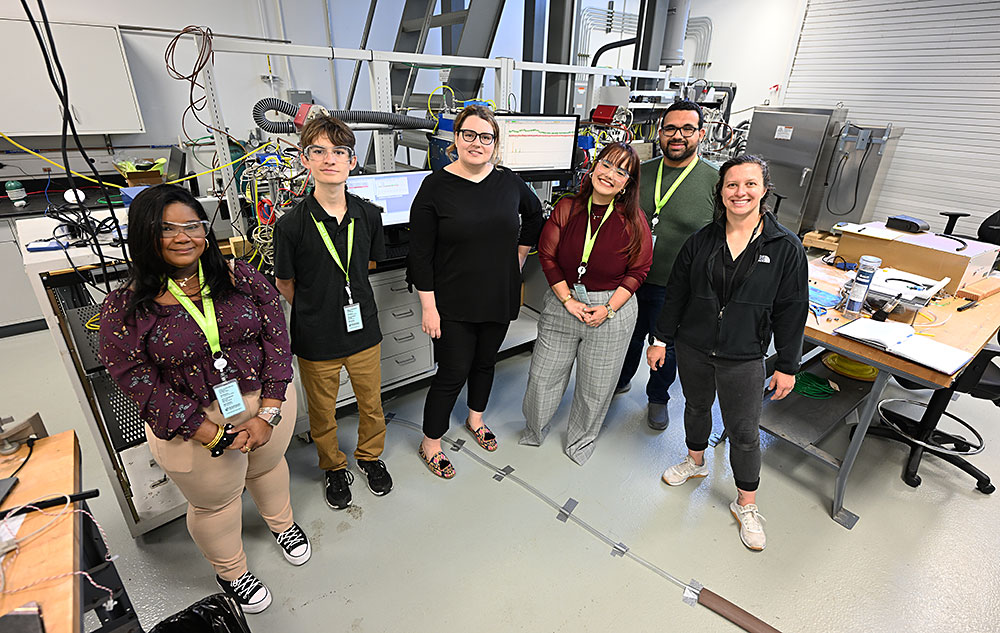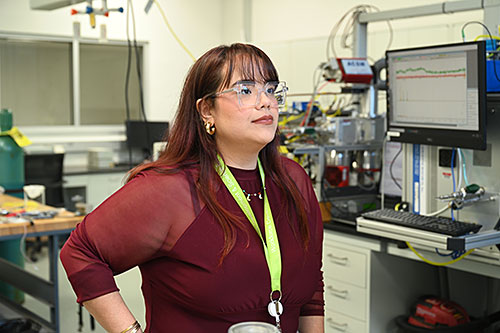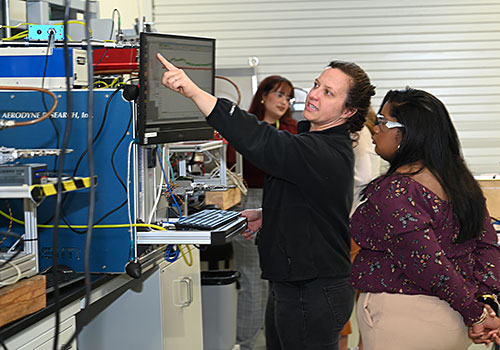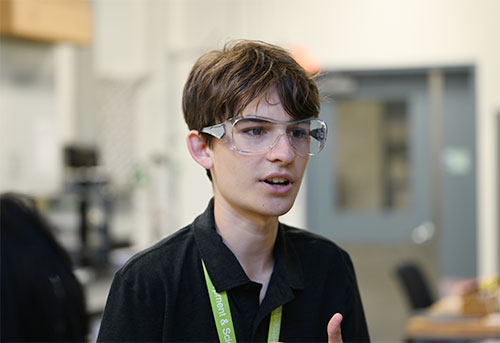Instrumental: Brookhaven's Alabama-Bound Spectrometer
Atmospheric scientist and interns calibrate aerosol-sampling instrument ahead of its deployment to Bankhead National Forest
August 22, 2024
 enlarge
enlarge
Environmental scientist Maria Zawadowicz's team stands in front of mass spectrometry equipment in a Center for Aerosol Measurement Science laboratory at Brookhaven. Left to right: intern Keitza Ramos (University of Puerto Rico, Río Piedras), intern Jackson Normandin (Northeastern University), Zawadowicz, intern Pamela Acevedo (University of Puerto Rico, Río Piedras), intern Adrian Cortes Santos (University of Puerto Rico, Río Piedras), and postdoctoral fellow Amie Dobracki. (Kevin Coughlin/Brookhaven National Laboratory)
What populates Alabama’s William Bankhead National Forest? Trees might be the first thing that come to mind — or maybe deer. But a lot of sophisticated scientific instruments are joining the natural forest occupants thanks to a U.S. Department of Energy (DOE) research facility being set up there to study connections between the forest and atmosphere.
But before these sensitive tools are installed among the trees, staff from DOE’s Atmospheric Radiation Measurement (ARM) user facility need to ensure the instruments’ precision and accuracy. Otherwise, the information they collect could be for naught.
Some of this verification work is taking place at the new Center for Aerosol Measurement Science (CAMS) at DOE’s Brookhaven National Laboratory. CAMS scientists calibrate aerosol instrumentation according to standard samples of aerosols — tiny particles suspended in the atmosphere that can trigger the formation of clouds.
 enlarge
enlarge
Acevedo looks on as Zawadowicz (out of frame) explains how a mass spectrometer works. (Kevin Coughlin/Brookhaven National Laboratory)
At CAMS, Maria Zawadowicz, a Brookhaven Lab scientist in the Environmental and Climate Sciences Department, is working with a group of interns to perform an intercomparison study of aerosol mass spectrometers, one of which will be deployed to Bankhead. By running an intercomparison of these advanced aerosol instruments, they’re priming the one destined for northern Alabama to make the best possible long-term measurements.
“What I’m very interested in is how biological aerosols influence climate and ecosystems,” Zawadowicz shared, noting that aerosols can come from a mixture of natural and human-made sources.
“For example, aerosols can be emitted from car tailpipes directly or formed from pollutants in the atmosphere,” Zawadowicz said. But at the same time, “trees and other plants emit gaseous compounds, which are then converted to aerosols in the atmosphere through a series of chemical reactions.
“In addition, because of where Alabama is, and because of how highly vegetated it is, I think there will also be a lot of other natural aerosols — pollen, spores, and bacteria — released into the atmosphere. It's possible that these particles play a big role in influencing the local climate of the region,” she said.
ARMed with data
The spectrometer will be one of many instruments that make up ARM’s Bankhead National Forest atmospheric observatory, which has the overall objective of bringing high-quality data to atmospheric scientists who study how plants interact with clouds and aerosols.
 enlarge
enlarge
Dobracki points out a detail of the CAMS ceiling inlet (out of frame) to Ramos. The inlet draws air from outside the building into the lab for testing. (Kevin Coughlin/Brookhaven National Laboratory)
Brookhaven scientists led the site selection and development of a science plan for the Bankhead observatory. Colleagues from DOE’s Argonne National Laboratory are overseeing the installation of instruments within and outside the forest as well as managing site operations at the observatory, which is scheduled to open this fall.
Many of the aerosol instruments will be installed in a retrofitted shipping container known as an Aerosol Observing System (AOS). In Bankhead, ARM will operate one AOS, and a second will be set up for researchers at other institutions. Each AOS has an inlet that draws outside air into conductive tubing that in turn directs the ambient samples to individual instruments for many kinds of analysis.
Aerosol mass spectrometers, like the one Zawadowicz’s team is calibrating, analyze an array of the particles’ physical and chemical characteristics. “These are particles on the order of a couple nanometers to a few hundreds of nanometers in size,” Zawadowicz explained. Electromagnetic fields inside the spectrometer segregate the particles based on their size and electrical charge so scientists can begin to unravel information about their chemical composition and, ultimately, their origins.
Zawadowicz is fine-tuning four mass spectrometers in total. All are commercial instruments, but each will be deployed to a different region at ARM-managed sites in Alaska, Oklahoma, and Maryland, in addition to Alabama.
As comparable as possible
The idea behind instrument intercomparisons is to ensure one machine’s performance is comparable to another’s. It’s like making sure that at 86 degrees Fahrenheit, two thermometers show just that — an accurate temperature. Otherwise, one or both instruments can’t be trusted.
“Are we measuring the same thing in Alaska that we are in Alabama?” Zawadowicz asked. “Obviously, the conditions at these two places aren’t the same. But we need to make sure that the instrument is responding to the same conditions in the same way. That’s why we have them all in the lab here: to verify that when conditions are the same, the instruments will measure the same thing.”
That intercomparison starts by producing common reference particles to calibrate machine responses. To generate these uber-tiny particles from a solution, Zawadowicz mixes ammonium nitrate, sulfate, and other chemicals present in the atmosphere using water as a solvent. “We turn these into droplets, which we then dry to make very small particles,” she continued.
Knowing the input — the chemistry and concentration of particles — enables the team to verify that the detector is in fact yielding the correct output.
The bigger particle picture
Zawadowicz’s summer interns are also providing valuable context for this mass spectrometry testing.
Pamela Acevedo, a graduate student at the University of Puerto Rico at Río Piedras, is analyzing bioaerosols, such as pollen from plants, spores from fungi, and even dander from domestic and wild animals. As Acevedo put it, “Bioaerosols are from things that live or have once lived.”
At Brookhaven’s CAMS laboratory, bioaerosols get drawn into the lab through an inlet in the ceiling, a near-perfect replica of the AOS version of the ambient air tube, or aerosol inlet.
"That’s why we have them all in the lab here: to verify that when conditions are the same, the instruments will measure the same thing."
— Maria Zawadowicz Brookhaven Lab scientist in the Environmental and Climate Sciences Department
Mass spectrometers analyze super-tiny particles. Acevedo, by contrast, collects aerosols that are much bigger, usually larger than one micron. Nevertheless, they serve as an informational complement to their more miniature counterparts.
Zawadowicz clarified: “We have a special class of instruments that enable us to sample coarse-mode aerosols bigger than one micron. Particles that large are generally more difficult to sample, as they have more inertia and don’t maneuver around corners in the sampling system very well. So, we have to take care to minimize the path from the inlet to the instrument.”
Acevedo uses one such specialized coarse-mode instrument called a Wideband Integrated Bioaerosol Sensor (WIBS) to determine what’s in the air more generally on a given day.
“The WIBS gives us variables like particle concentration, size, and ‘asphericity,’” Acevedo said. Asphericity refers to how much the particle shape differs from a perfect sphere. These characteristics help scientists answer questions such as: Is there a lot of pollen? Is biomass burning nearby? That important background will inform subsequent mass spectrometry readings — including those taken in Bankhead.
Intern Jackson Normandin from Northeastern University is not looking at bioaerosols but is still investigating a topic that will provide valuable context for the Bankhead study.
“One area of our research concerns aerosol particles that have been coated with another substance,” Normandin reported. He mentioned that such coatings can come from volatile organic compounds emitted into the atmosphere by industry or from burning vegetation. “Aerosol particles can gain and lose their coatings over time, which alters their physical, chemical, and optical properties,” along with their potential to form clouds, he said.
 enlarge
enlarge
Normandin explains his summer research on aerosol coatings to a visiting reporter. (Kevin Coughlin/Brookhaven National Laboratory)
In the lab, Normandin is trying to simulate how aerosol coatings form to mimic the process that occurs in the atmosphere. He vaporizes the coating substance in a chamber and then lets it condense onto particles flowing into the chamber.
“One particularly fascinating application of laboratory-generated coated particles is that we can artificially age the coating,” Normandin noted. “This simulates the evolution of coatings in the atmosphere and can allow us to develop a greater understanding of the properties of coated particles and how they change over time.”
Normandin is talking about changes over hours or days. The Bankhead observatory, which seeks to answer related but nonetheless different research questions, will be collecting data over at least five years to study both short- and long-time scale processes.
That’s another reason the reliability of scientific instruments is so valuable. “If we are confident in the stability of our instruments before deployment, then we will be confident the observations we make even over many years are due to the atmospheric conditions rather than irregularities in the instruments,” said Chongai Kuang of Brookhaven’s Environmental and Climate Sciences Department. Kuang led the multi-institutional team that developed the science plan for the Bankhead observatory with support from ARM and DOE’s Atmospheric System Research program. He predicts there may be some variation in data collected due to “seasonality in the emission” of certain aerosols or maybe interactions among “local and regional aerosol formation processes.” Well-performing instruments are essential for discerning these differences, he said.
Next, Zawadowicz will travel to Alabama to install the mass spectrometer in the AOS. “As an ‘instrument mentor,’ I calibrate the instruments, I make sure that they get to their destination safely, I install them, and I make sure that they provide quality-controlled data,” she said.
In short, trustworthy science requires trustworthy data. And there can’t be either without trustworthy instruments.
Brookhaven National Laboratory is supported by the Office of Science of the U.S. Department of Energy. The Office of Science is the single largest supporter of basic research in the physical sciences in the United States and is working to address some of the most pressing challenges of our time. For more information, visit science.energy.gov.
Follow @BrookhavenLab on social media. Find us on Instagram, LinkedIn, X, and Facebook.
2024-22027 | INT/EXT | Newsroom









